NUR5326 Report: Hand Hygiene and Infection Control
VerifiedAdded on 2022/10/02
|17
|3553
|117
Report
AI Summary
This report, prepared by a student, focuses on the critical role of hand hygiene in preventing healthcare-associated infections (HAIs). It begins with an introduction highlighting the significance of clinical quality and safety in healthcare settings, referencing national standards and the impact of HAIs. The report then provides a rationale and literature review, emphasizing the transmission of infections and the importance of preventive measures, such as hand hygiene. The goal is to minimize infections through increased awareness and improved hand hygiene practices among healthcare workers. A quality improvement framework is presented to guide implementation and evaluation, followed by an overview of the implementation strategy, which includes education, communication, and practical training. The report details evaluation methods, such as clinical audits and PDSA cycles, to assess the effectiveness of the implemented strategies. Finally, a sustainability plan is discussed, and the report concludes with a summary of the key findings and recommendations for improving patient safety through effective hand hygiene practices. The report underscores the importance of continuous monitoring and improvement to achieve better patient outcomes and maintain a safe healthcare environment.
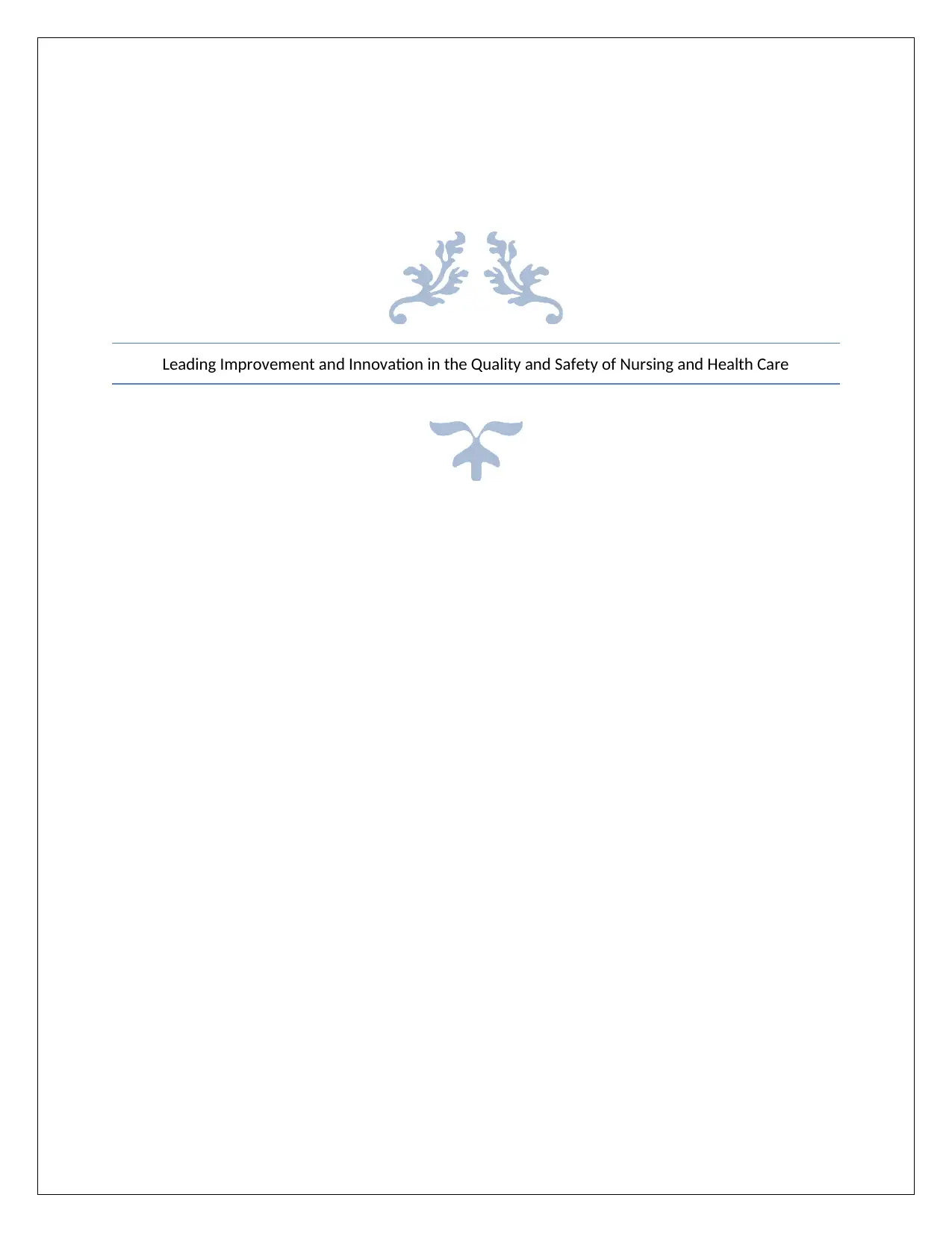
Leading Improvement and Innovation in the Quality and Safety of Nursing and Health Care
Paraphrase This Document
Need a fresh take? Get an instant paraphrase of this document with our AI Paraphraser
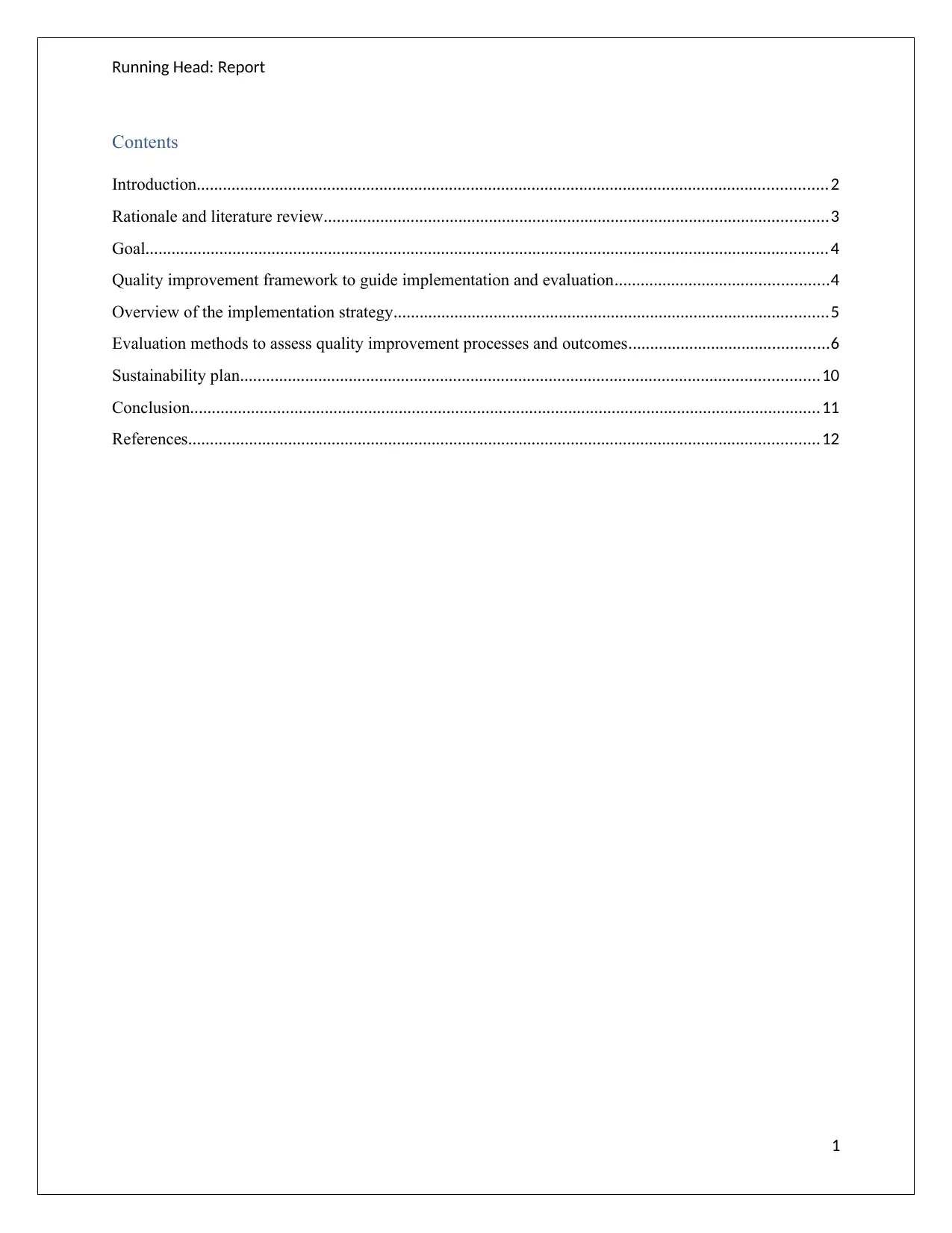
Running Head: Report
Contents
Introduction.................................................................................................................................................2
Rationale and literature review....................................................................................................................3
Goal.............................................................................................................................................................4
Quality improvement framework to guide implementation and evaluation.................................................4
Overview of the implementation strategy....................................................................................................5
Evaluation methods to assess quality improvement processes and outcomes..............................................6
Sustainability plan.....................................................................................................................................10
Conclusion.................................................................................................................................................11
References.................................................................................................................................................12
1
Contents
Introduction.................................................................................................................................................2
Rationale and literature review....................................................................................................................3
Goal.............................................................................................................................................................4
Quality improvement framework to guide implementation and evaluation.................................................4
Overview of the implementation strategy....................................................................................................5
Evaluation methods to assess quality improvement processes and outcomes..............................................6
Sustainability plan.....................................................................................................................................10
Conclusion.................................................................................................................................................11
References.................................................................................................................................................12
1
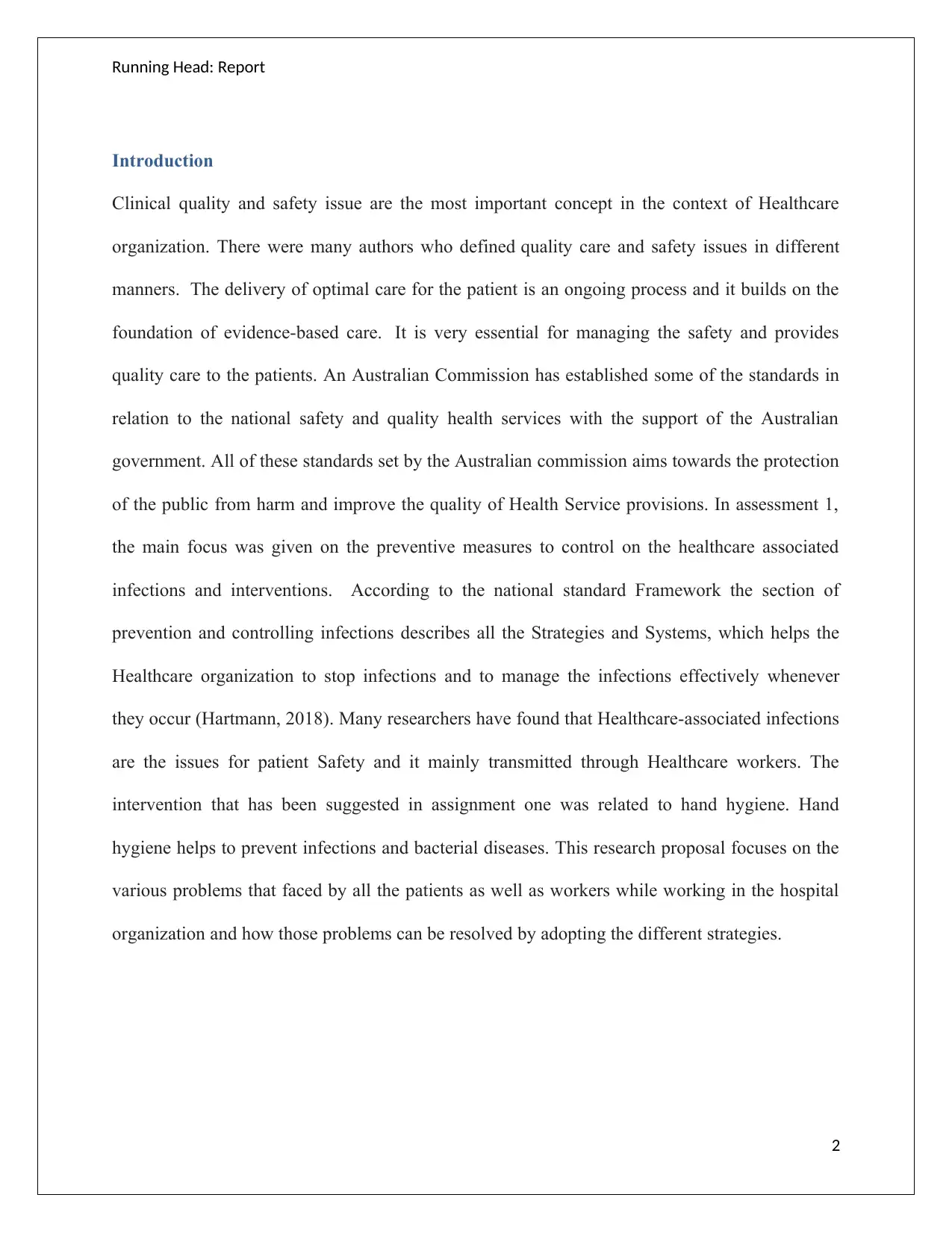
Running Head: Report
Introduction
Clinical quality and safety issue are the most important concept in the context of Healthcare
organization. There were many authors who defined quality care and safety issues in different
manners. The delivery of optimal care for the patient is an ongoing process and it builds on the
foundation of evidence-based care. It is very essential for managing the safety and provides
quality care to the patients. An Australian Commission has established some of the standards in
relation to the national safety and quality health services with the support of the Australian
government. All of these standards set by the Australian commission aims towards the protection
of the public from harm and improve the quality of Health Service provisions. In assessment 1,
the main focus was given on the preventive measures to control on the healthcare associated
infections and interventions. According to the national standard Framework the section of
prevention and controlling infections describes all the Strategies and Systems, which helps the
Healthcare organization to stop infections and to manage the infections effectively whenever
they occur (Hartmann, 2018). Many researchers have found that Healthcare-associated infections
are the issues for patient Safety and it mainly transmitted through Healthcare workers. The
intervention that has been suggested in assignment one was related to hand hygiene. Hand
hygiene helps to prevent infections and bacterial diseases. This research proposal focuses on the
various problems that faced by all the patients as well as workers while working in the hospital
organization and how those problems can be resolved by adopting the different strategies.
2
Introduction
Clinical quality and safety issue are the most important concept in the context of Healthcare
organization. There were many authors who defined quality care and safety issues in different
manners. The delivery of optimal care for the patient is an ongoing process and it builds on the
foundation of evidence-based care. It is very essential for managing the safety and provides
quality care to the patients. An Australian Commission has established some of the standards in
relation to the national safety and quality health services with the support of the Australian
government. All of these standards set by the Australian commission aims towards the protection
of the public from harm and improve the quality of Health Service provisions. In assessment 1,
the main focus was given on the preventive measures to control on the healthcare associated
infections and interventions. According to the national standard Framework the section of
prevention and controlling infections describes all the Strategies and Systems, which helps the
Healthcare organization to stop infections and to manage the infections effectively whenever
they occur (Hartmann, 2018). Many researchers have found that Healthcare-associated infections
are the issues for patient Safety and it mainly transmitted through Healthcare workers. The
intervention that has been suggested in assignment one was related to hand hygiene. Hand
hygiene helps to prevent infections and bacterial diseases. This research proposal focuses on the
various problems that faced by all the patients as well as workers while working in the hospital
organization and how those problems can be resolved by adopting the different strategies.
2
⊘ This is a preview!⊘
Do you want full access?
Subscribe today to unlock all pages.

Trusted by 1+ million students worldwide
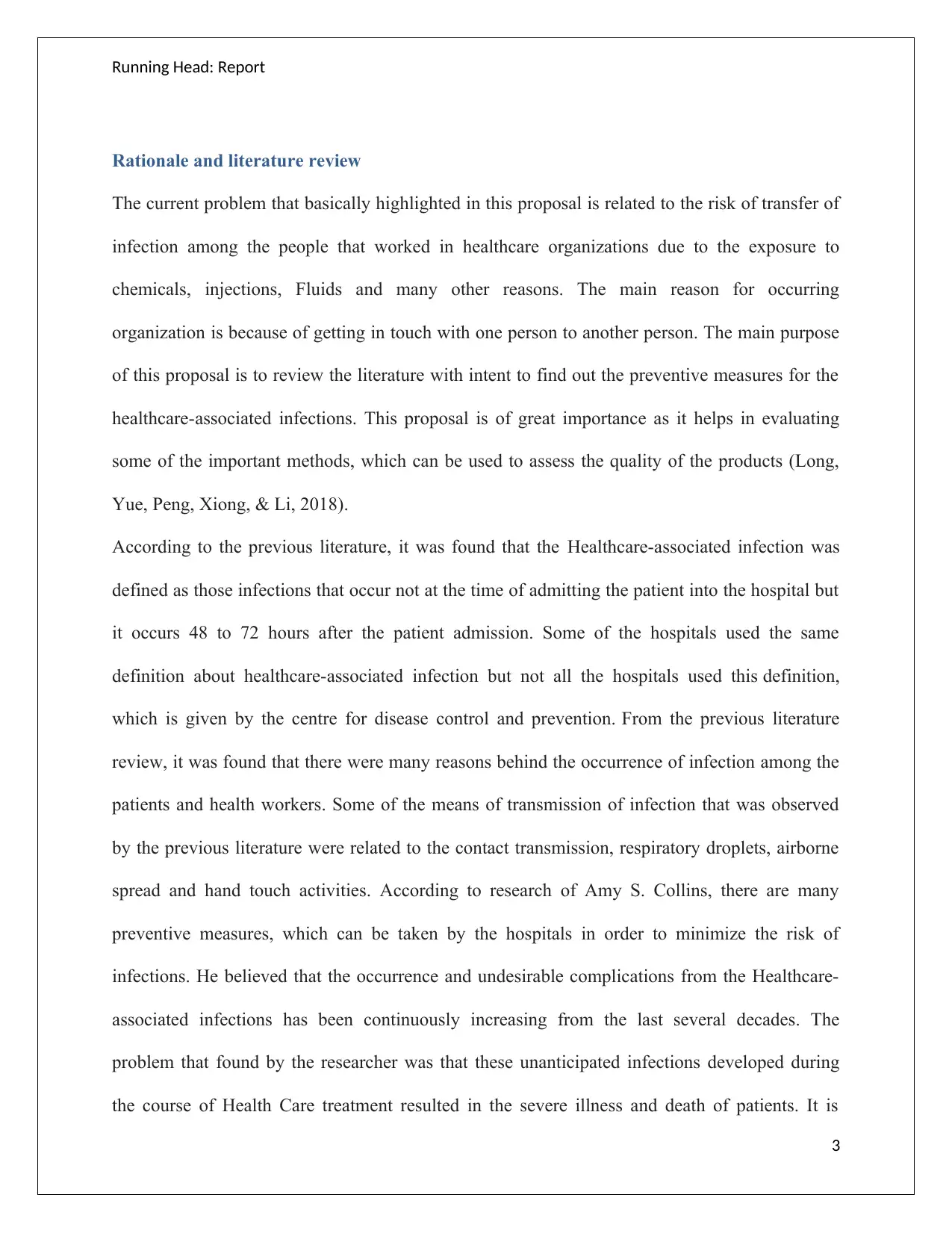
Running Head: Report
Rationale and literature review
The current problem that basically highlighted in this proposal is related to the risk of transfer of
infection among the people that worked in healthcare organizations due to the exposure to
chemicals, injections, Fluids and many other reasons. The main reason for occurring
organization is because of getting in touch with one person to another person. The main purpose
of this proposal is to review the literature with intent to find out the preventive measures for the
healthcare-associated infections. This proposal is of great importance as it helps in evaluating
some of the important methods, which can be used to assess the quality of the products (Long,
Yue, Peng, Xiong, & Li, 2018).
According to the previous literature, it was found that the Healthcare-associated infection was
defined as those infections that occur not at the time of admitting the patient into the hospital but
it occurs 48 to 72 hours after the patient admission. Some of the hospitals used the same
definition about healthcare-associated infection but not all the hospitals used this definition,
which is given by the centre for disease control and prevention. From the previous literature
review, it was found that there were many reasons behind the occurrence of infection among the
patients and health workers. Some of the means of transmission of infection that was observed
by the previous literature were related to the contact transmission, respiratory droplets, airborne
spread and hand touch activities. According to research of Amy S. Collins, there are many
preventive measures, which can be taken by the hospitals in order to minimize the risk of
infections. He believed that the occurrence and undesirable complications from the Healthcare-
associated infections has been continuously increasing from the last several decades. The
problem that found by the researcher was that these unanticipated infections developed during
the course of Health Care treatment resulted in the severe illness and death of patients. It is
3
Rationale and literature review
The current problem that basically highlighted in this proposal is related to the risk of transfer of
infection among the people that worked in healthcare organizations due to the exposure to
chemicals, injections, Fluids and many other reasons. The main reason for occurring
organization is because of getting in touch with one person to another person. The main purpose
of this proposal is to review the literature with intent to find out the preventive measures for the
healthcare-associated infections. This proposal is of great importance as it helps in evaluating
some of the important methods, which can be used to assess the quality of the products (Long,
Yue, Peng, Xiong, & Li, 2018).
According to the previous literature, it was found that the Healthcare-associated infection was
defined as those infections that occur not at the time of admitting the patient into the hospital but
it occurs 48 to 72 hours after the patient admission. Some of the hospitals used the same
definition about healthcare-associated infection but not all the hospitals used this definition,
which is given by the centre for disease control and prevention. From the previous literature
review, it was found that there were many reasons behind the occurrence of infection among the
patients and health workers. Some of the means of transmission of infection that was observed
by the previous literature were related to the contact transmission, respiratory droplets, airborne
spread and hand touch activities. According to research of Amy S. Collins, there are many
preventive measures, which can be taken by the hospitals in order to minimize the risk of
infections. He believed that the occurrence and undesirable complications from the Healthcare-
associated infections has been continuously increasing from the last several decades. The
problem that found by the researcher was that these unanticipated infections developed during
the course of Health Care treatment resulted in the severe illness and death of patients. It is
3
Paraphrase This Document
Need a fresh take? Get an instant paraphrase of this document with our AI Paraphraser
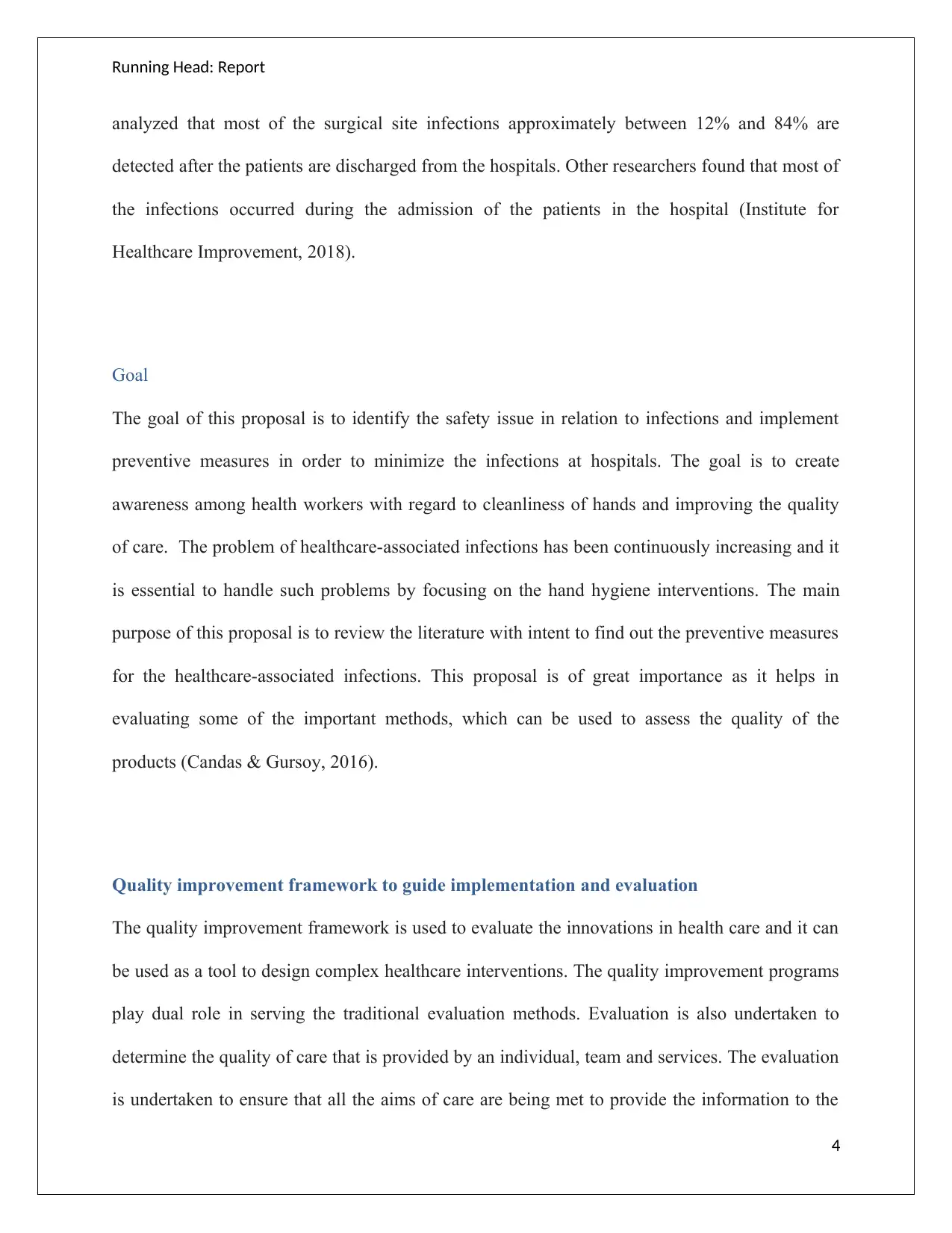
Running Head: Report
analyzed that most of the surgical site infections approximately between 12% and 84% are
detected after the patients are discharged from the hospitals. Other researchers found that most of
the infections occurred during the admission of the patients in the hospital (Institute for
Healthcare Improvement, 2018).
Goal
The goal of this proposal is to identify the safety issue in relation to infections and implement
preventive measures in order to minimize the infections at hospitals. The goal is to create
awareness among health workers with regard to cleanliness of hands and improving the quality
of care. The problem of healthcare-associated infections has been continuously increasing and it
is essential to handle such problems by focusing on the hand hygiene interventions. The main
purpose of this proposal is to review the literature with intent to find out the preventive measures
for the healthcare-associated infections. This proposal is of great importance as it helps in
evaluating some of the important methods, which can be used to assess the quality of the
products (Candas & Gursoy, 2016).
Quality improvement framework to guide implementation and evaluation
The quality improvement framework is used to evaluate the innovations in health care and it can
be used as a tool to design complex healthcare interventions. The quality improvement programs
play dual role in serving the traditional evaluation methods. Evaluation is also undertaken to
determine the quality of care that is provided by an individual, team and services. The evaluation
is undertaken to ensure that all the aims of care are being met to provide the information to the
4
analyzed that most of the surgical site infections approximately between 12% and 84% are
detected after the patients are discharged from the hospitals. Other researchers found that most of
the infections occurred during the admission of the patients in the hospital (Institute for
Healthcare Improvement, 2018).
Goal
The goal of this proposal is to identify the safety issue in relation to infections and implement
preventive measures in order to minimize the infections at hospitals. The goal is to create
awareness among health workers with regard to cleanliness of hands and improving the quality
of care. The problem of healthcare-associated infections has been continuously increasing and it
is essential to handle such problems by focusing on the hand hygiene interventions. The main
purpose of this proposal is to review the literature with intent to find out the preventive measures
for the healthcare-associated infections. This proposal is of great importance as it helps in
evaluating some of the important methods, which can be used to assess the quality of the
products (Candas & Gursoy, 2016).
Quality improvement framework to guide implementation and evaluation
The quality improvement framework is used to evaluate the innovations in health care and it can
be used as a tool to design complex healthcare interventions. The quality improvement programs
play dual role in serving the traditional evaluation methods. Evaluation is also undertaken to
determine the quality of care that is provided by an individual, team and services. The evaluation
is undertaken to ensure that all the aims of care are being met to provide the information to the
4
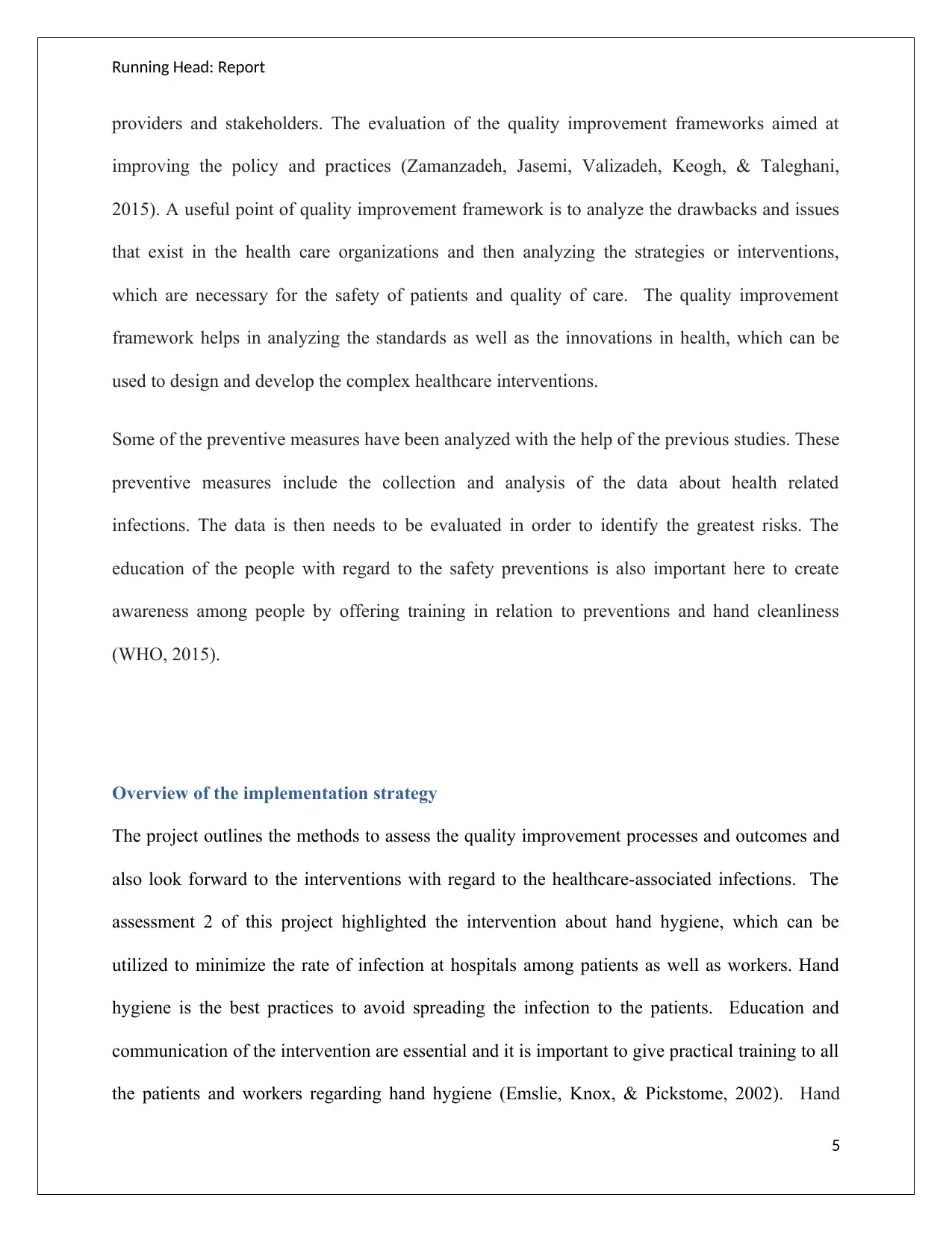
Running Head: Report
providers and stakeholders. The evaluation of the quality improvement frameworks aimed at
improving the policy and practices (Zamanzadeh, Jasemi, Valizadeh, Keogh, & Taleghani,
2015). A useful point of quality improvement framework is to analyze the drawbacks and issues
that exist in the health care organizations and then analyzing the strategies or interventions,
which are necessary for the safety of patients and quality of care. The quality improvement
framework helps in analyzing the standards as well as the innovations in health, which can be
used to design and develop the complex healthcare interventions.
Some of the preventive measures have been analyzed with the help of the previous studies. These
preventive measures include the collection and analysis of the data about health related
infections. The data is then needs to be evaluated in order to identify the greatest risks. The
education of the people with regard to the safety preventions is also important here to create
awareness among people by offering training in relation to preventions and hand cleanliness
(WHO, 2015).
Overview of the implementation strategy
The project outlines the methods to assess the quality improvement processes and outcomes and
also look forward to the interventions with regard to the healthcare-associated infections. The
assessment 2 of this project highlighted the intervention about hand hygiene, which can be
utilized to minimize the rate of infection at hospitals among patients as well as workers. Hand
hygiene is the best practices to avoid spreading the infection to the patients. Education and
communication of the intervention are essential and it is important to give practical training to all
the patients and workers regarding hand hygiene (Emslie, Knox, & Pickstome, 2002). Hand
5
providers and stakeholders. The evaluation of the quality improvement frameworks aimed at
improving the policy and practices (Zamanzadeh, Jasemi, Valizadeh, Keogh, & Taleghani,
2015). A useful point of quality improvement framework is to analyze the drawbacks and issues
that exist in the health care organizations and then analyzing the strategies or interventions,
which are necessary for the safety of patients and quality of care. The quality improvement
framework helps in analyzing the standards as well as the innovations in health, which can be
used to design and develop the complex healthcare interventions.
Some of the preventive measures have been analyzed with the help of the previous studies. These
preventive measures include the collection and analysis of the data about health related
infections. The data is then needs to be evaluated in order to identify the greatest risks. The
education of the people with regard to the safety preventions is also important here to create
awareness among people by offering training in relation to preventions and hand cleanliness
(WHO, 2015).
Overview of the implementation strategy
The project outlines the methods to assess the quality improvement processes and outcomes and
also look forward to the interventions with regard to the healthcare-associated infections. The
assessment 2 of this project highlighted the intervention about hand hygiene, which can be
utilized to minimize the rate of infection at hospitals among patients as well as workers. Hand
hygiene is the best practices to avoid spreading the infection to the patients. Education and
communication of the intervention are essential and it is important to give practical training to all
the patients and workers regarding hand hygiene (Emslie, Knox, & Pickstome, 2002). Hand
5
⊘ This is a preview!⊘
Do you want full access?
Subscribe today to unlock all pages.

Trusted by 1+ million students worldwide
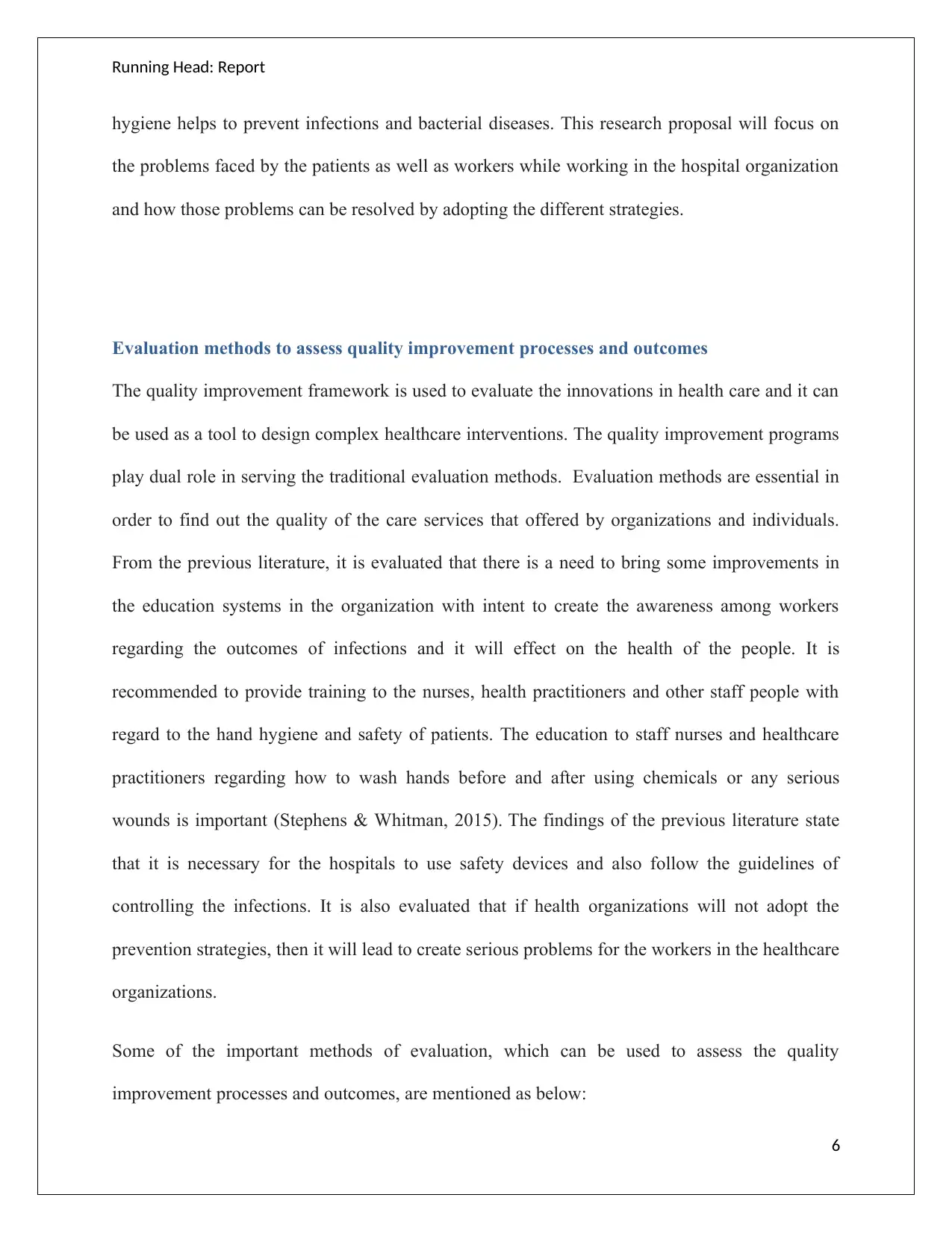
Running Head: Report
hygiene helps to prevent infections and bacterial diseases. This research proposal will focus on
the problems faced by the patients as well as workers while working in the hospital organization
and how those problems can be resolved by adopting the different strategies.
Evaluation methods to assess quality improvement processes and outcomes
The quality improvement framework is used to evaluate the innovations in health care and it can
be used as a tool to design complex healthcare interventions. The quality improvement programs
play dual role in serving the traditional evaluation methods. Evaluation methods are essential in
order to find out the quality of the care services that offered by organizations and individuals.
From the previous literature, it is evaluated that there is a need to bring some improvements in
the education systems in the organization with intent to create the awareness among workers
regarding the outcomes of infections and it will effect on the health of the people. It is
recommended to provide training to the nurses, health practitioners and other staff people with
regard to the hand hygiene and safety of patients. The education to staff nurses and healthcare
practitioners regarding how to wash hands before and after using chemicals or any serious
wounds is important (Stephens & Whitman, 2015). The findings of the previous literature state
that it is necessary for the hospitals to use safety devices and also follow the guidelines of
controlling the infections. It is also evaluated that if health organizations will not adopt the
prevention strategies, then it will lead to create serious problems for the workers in the healthcare
organizations.
Some of the important methods of evaluation, which can be used to assess the quality
improvement processes and outcomes, are mentioned as below:
6
hygiene helps to prevent infections and bacterial diseases. This research proposal will focus on
the problems faced by the patients as well as workers while working in the hospital organization
and how those problems can be resolved by adopting the different strategies.
Evaluation methods to assess quality improvement processes and outcomes
The quality improvement framework is used to evaluate the innovations in health care and it can
be used as a tool to design complex healthcare interventions. The quality improvement programs
play dual role in serving the traditional evaluation methods. Evaluation methods are essential in
order to find out the quality of the care services that offered by organizations and individuals.
From the previous literature, it is evaluated that there is a need to bring some improvements in
the education systems in the organization with intent to create the awareness among workers
regarding the outcomes of infections and it will effect on the health of the people. It is
recommended to provide training to the nurses, health practitioners and other staff people with
regard to the hand hygiene and safety of patients. The education to staff nurses and healthcare
practitioners regarding how to wash hands before and after using chemicals or any serious
wounds is important (Stephens & Whitman, 2015). The findings of the previous literature state
that it is necessary for the hospitals to use safety devices and also follow the guidelines of
controlling the infections. It is also evaluated that if health organizations will not adopt the
prevention strategies, then it will lead to create serious problems for the workers in the healthcare
organizations.
Some of the important methods of evaluation, which can be used to assess the quality
improvement processes and outcomes, are mentioned as below:
6
Paraphrase This Document
Need a fresh take? Get an instant paraphrase of this document with our AI Paraphraser
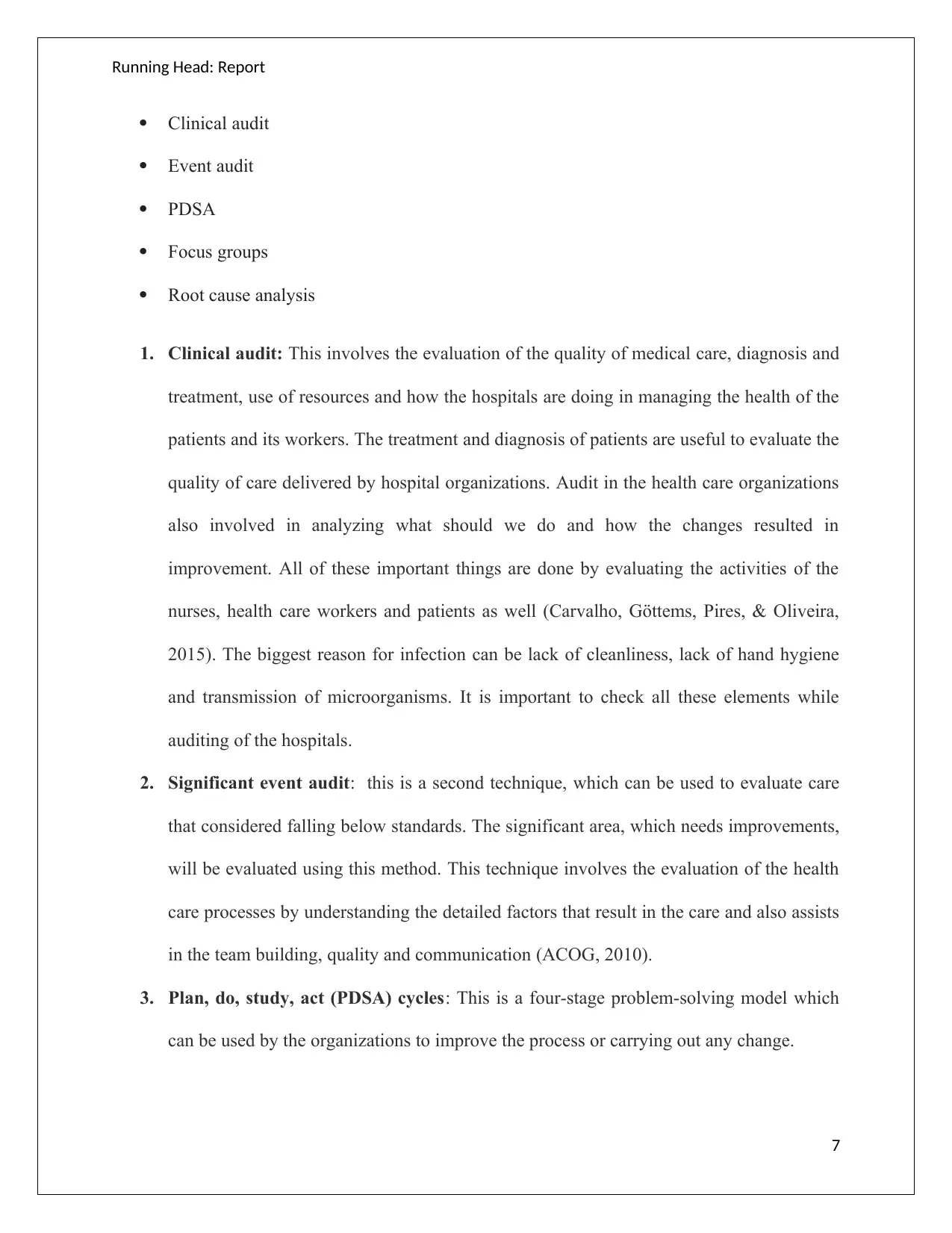
Running Head: Report
Clinical audit
Event audit
PDSA
Focus groups
Root cause analysis
1. Clinical audit: This involves the evaluation of the quality of medical care, diagnosis and
treatment, use of resources and how the hospitals are doing in managing the health of the
patients and its workers. The treatment and diagnosis of patients are useful to evaluate the
quality of care delivered by hospital organizations. Audit in the health care organizations
also involved in analyzing what should we do and how the changes resulted in
improvement. All of these important things are done by evaluating the activities of the
nurses, health care workers and patients as well (Carvalho, Göttems, Pires, & Oliveira,
2015). The biggest reason for infection can be lack of cleanliness, lack of hand hygiene
and transmission of microorganisms. It is important to check all these elements while
auditing of the hospitals.
2. Significant event audit: this is a second technique, which can be used to evaluate care
that considered falling below standards. The significant area, which needs improvements,
will be evaluated using this method. This technique involves the evaluation of the health
care processes by understanding the detailed factors that result in the care and also assists
in the team building, quality and communication (ACOG, 2010).
3. Plan, do, study, act (PDSA) cycles: This is a four-stage problem-solving model which
can be used by the organizations to improve the process or carrying out any change.
7
Clinical audit
Event audit
PDSA
Focus groups
Root cause analysis
1. Clinical audit: This involves the evaluation of the quality of medical care, diagnosis and
treatment, use of resources and how the hospitals are doing in managing the health of the
patients and its workers. The treatment and diagnosis of patients are useful to evaluate the
quality of care delivered by hospital organizations. Audit in the health care organizations
also involved in analyzing what should we do and how the changes resulted in
improvement. All of these important things are done by evaluating the activities of the
nurses, health care workers and patients as well (Carvalho, Göttems, Pires, & Oliveira,
2015). The biggest reason for infection can be lack of cleanliness, lack of hand hygiene
and transmission of microorganisms. It is important to check all these elements while
auditing of the hospitals.
2. Significant event audit: this is a second technique, which can be used to evaluate care
that considered falling below standards. The significant area, which needs improvements,
will be evaluated using this method. This technique involves the evaluation of the health
care processes by understanding the detailed factors that result in the care and also assists
in the team building, quality and communication (ACOG, 2010).
3. Plan, do, study, act (PDSA) cycles: This is a four-stage problem-solving model which
can be used by the organizations to improve the process or carrying out any change.
7
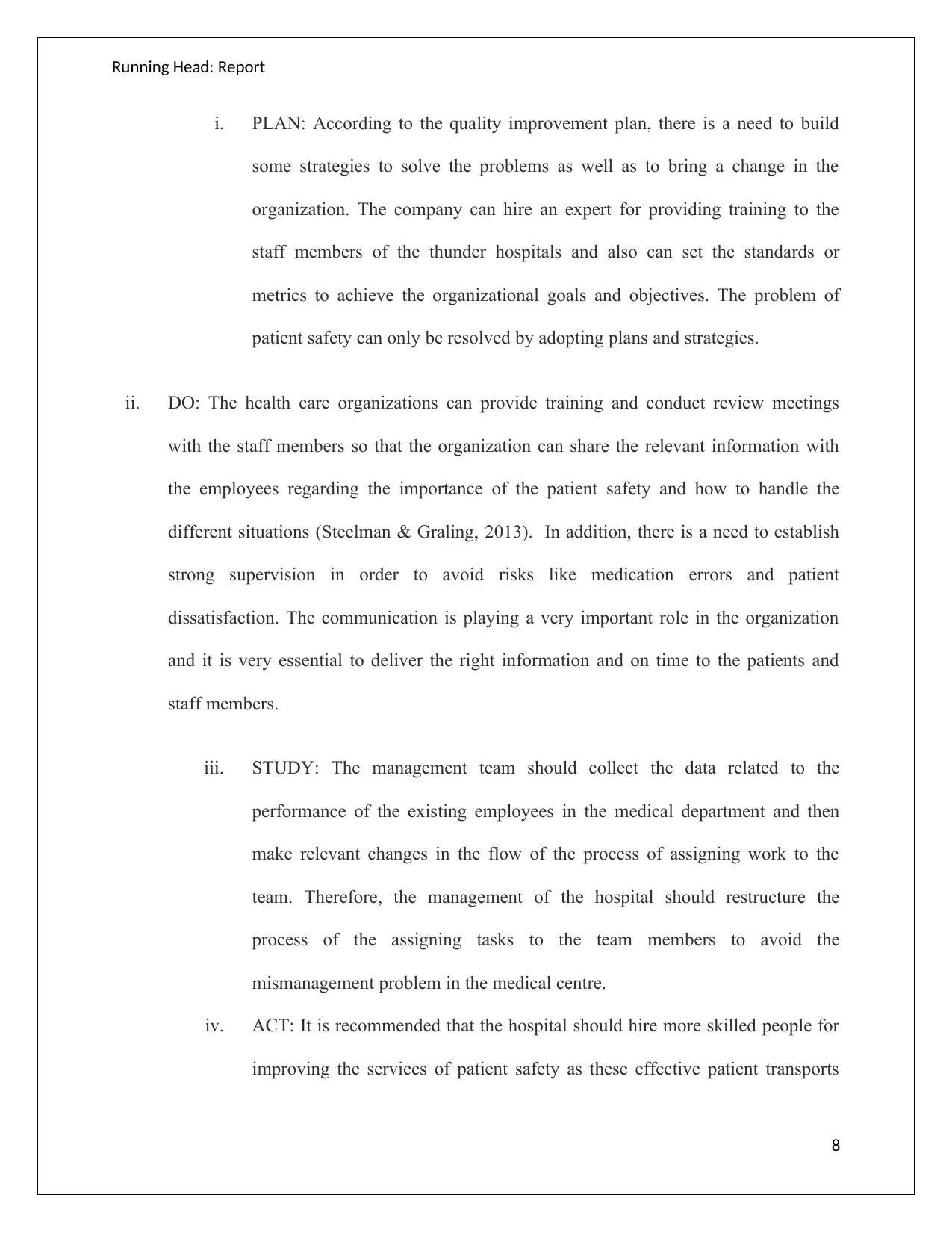
Running Head: Report
i. PLAN: According to the quality improvement plan, there is a need to build
some strategies to solve the problems as well as to bring a change in the
organization. The company can hire an expert for providing training to the
staff members of the thunder hospitals and also can set the standards or
metrics to achieve the organizational goals and objectives. The problem of
patient safety can only be resolved by adopting plans and strategies.
ii. DO: The health care organizations can provide training and conduct review meetings
with the staff members so that the organization can share the relevant information with
the employees regarding the importance of the patient safety and how to handle the
different situations (Steelman & Graling, 2013). In addition, there is a need to establish
strong supervision in order to avoid risks like medication errors and patient
dissatisfaction. The communication is playing a very important role in the organization
and it is very essential to deliver the right information and on time to the patients and
staff members.
iii. STUDY: The management team should collect the data related to the
performance of the existing employees in the medical department and then
make relevant changes in the flow of the process of assigning work to the
team. Therefore, the management of the hospital should restructure the
process of the assigning tasks to the team members to avoid the
mismanagement problem in the medical centre.
iv. ACT: It is recommended that the hospital should hire more skilled people for
improving the services of patient safety as these effective patient transports
8
i. PLAN: According to the quality improvement plan, there is a need to build
some strategies to solve the problems as well as to bring a change in the
organization. The company can hire an expert for providing training to the
staff members of the thunder hospitals and also can set the standards or
metrics to achieve the organizational goals and objectives. The problem of
patient safety can only be resolved by adopting plans and strategies.
ii. DO: The health care organizations can provide training and conduct review meetings
with the staff members so that the organization can share the relevant information with
the employees regarding the importance of the patient safety and how to handle the
different situations (Steelman & Graling, 2013). In addition, there is a need to establish
strong supervision in order to avoid risks like medication errors and patient
dissatisfaction. The communication is playing a very important role in the organization
and it is very essential to deliver the right information and on time to the patients and
staff members.
iii. STUDY: The management team should collect the data related to the
performance of the existing employees in the medical department and then
make relevant changes in the flow of the process of assigning work to the
team. Therefore, the management of the hospital should restructure the
process of the assigning tasks to the team members to avoid the
mismanagement problem in the medical centre.
iv. ACT: It is recommended that the hospital should hire more skilled people for
improving the services of patient safety as these effective patient transports
8
⊘ This is a preview!⊘
Do you want full access?
Subscribe today to unlock all pages.

Trusted by 1+ million students worldwide
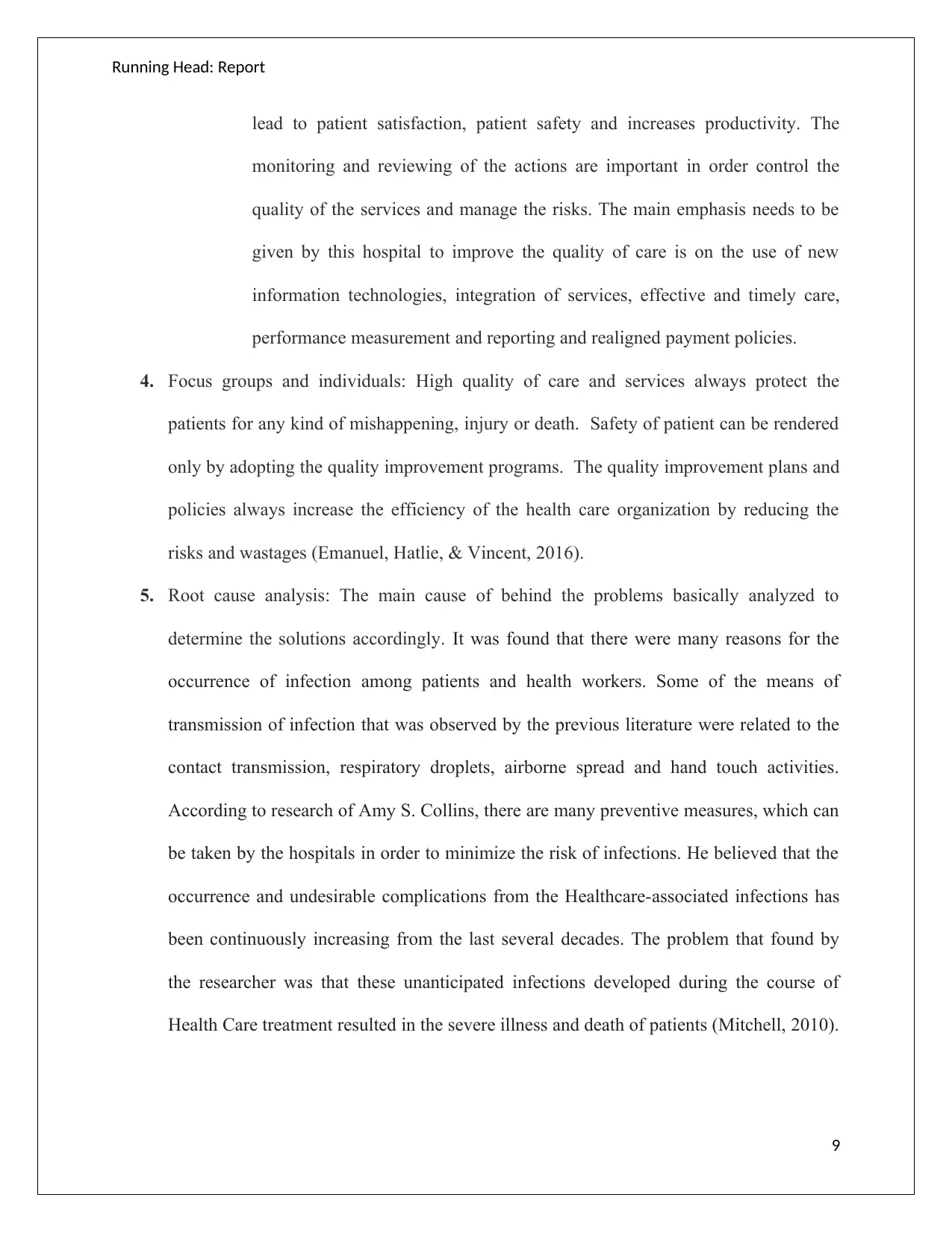
Running Head: Report
lead to patient satisfaction, patient safety and increases productivity. The
monitoring and reviewing of the actions are important in order control the
quality of the services and manage the risks. The main emphasis needs to be
given by this hospital to improve the quality of care is on the use of new
information technologies, integration of services, effective and timely care,
performance measurement and reporting and realigned payment policies.
4. Focus groups and individuals: High quality of care and services always protect the
patients for any kind of mishappening, injury or death. Safety of patient can be rendered
only by adopting the quality improvement programs. The quality improvement plans and
policies always increase the efficiency of the health care organization by reducing the
risks and wastages (Emanuel, Hatlie, & Vincent, 2016).
5. Root cause analysis: The main cause of behind the problems basically analyzed to
determine the solutions accordingly. It was found that there were many reasons for the
occurrence of infection among patients and health workers. Some of the means of
transmission of infection that was observed by the previous literature were related to the
contact transmission, respiratory droplets, airborne spread and hand touch activities.
According to research of Amy S. Collins, there are many preventive measures, which can
be taken by the hospitals in order to minimize the risk of infections. He believed that the
occurrence and undesirable complications from the Healthcare-associated infections has
been continuously increasing from the last several decades. The problem that found by
the researcher was that these unanticipated infections developed during the course of
Health Care treatment resulted in the severe illness and death of patients (Mitchell, 2010).
9
lead to patient satisfaction, patient safety and increases productivity. The
monitoring and reviewing of the actions are important in order control the
quality of the services and manage the risks. The main emphasis needs to be
given by this hospital to improve the quality of care is on the use of new
information technologies, integration of services, effective and timely care,
performance measurement and reporting and realigned payment policies.
4. Focus groups and individuals: High quality of care and services always protect the
patients for any kind of mishappening, injury or death. Safety of patient can be rendered
only by adopting the quality improvement programs. The quality improvement plans and
policies always increase the efficiency of the health care organization by reducing the
risks and wastages (Emanuel, Hatlie, & Vincent, 2016).
5. Root cause analysis: The main cause of behind the problems basically analyzed to
determine the solutions accordingly. It was found that there were many reasons for the
occurrence of infection among patients and health workers. Some of the means of
transmission of infection that was observed by the previous literature were related to the
contact transmission, respiratory droplets, airborne spread and hand touch activities.
According to research of Amy S. Collins, there are many preventive measures, which can
be taken by the hospitals in order to minimize the risk of infections. He believed that the
occurrence and undesirable complications from the Healthcare-associated infections has
been continuously increasing from the last several decades. The problem that found by
the researcher was that these unanticipated infections developed during the course of
Health Care treatment resulted in the severe illness and death of patients (Mitchell, 2010).
9
Paraphrase This Document
Need a fresh take? Get an instant paraphrase of this document with our AI Paraphraser
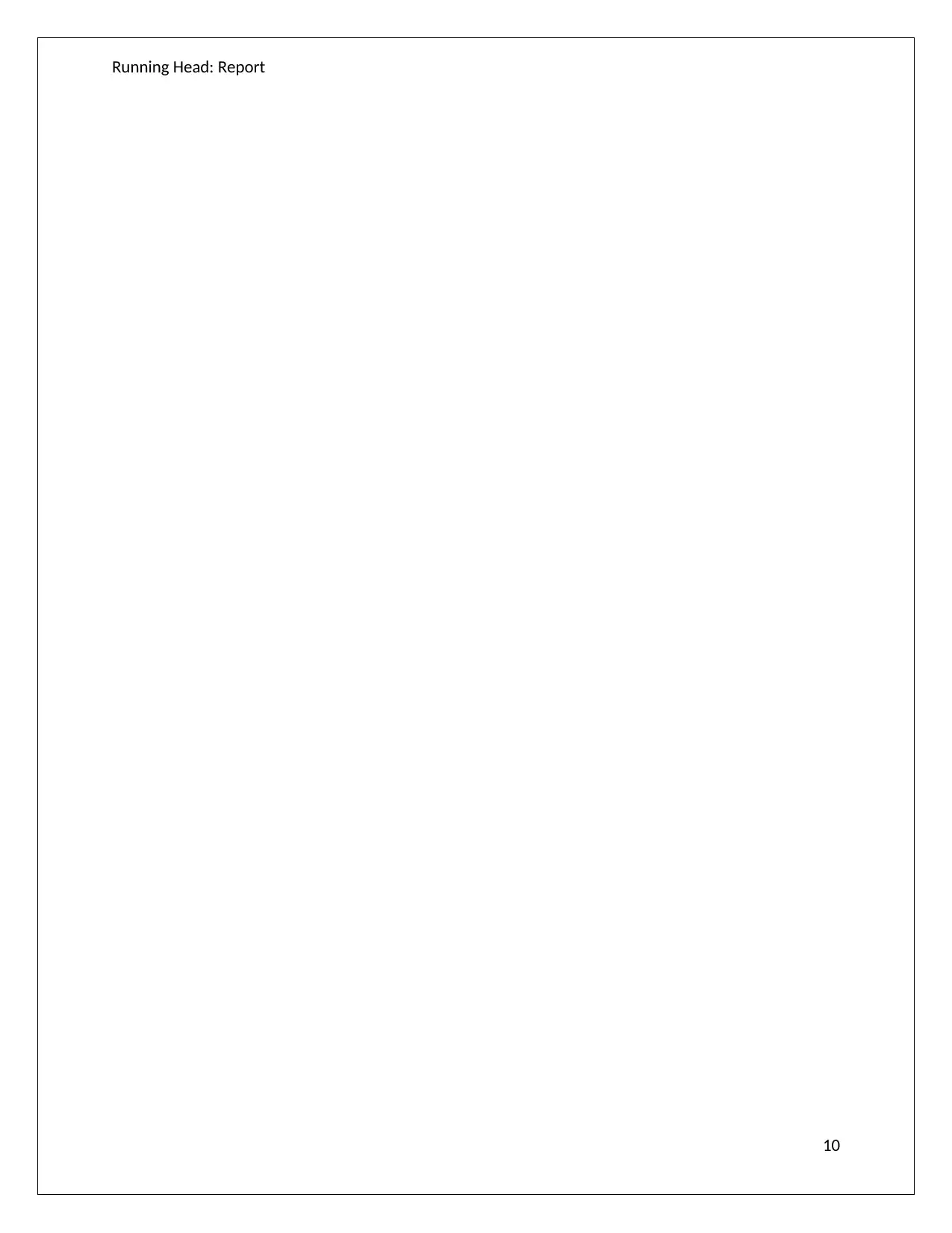
Running Head: Report
10
10
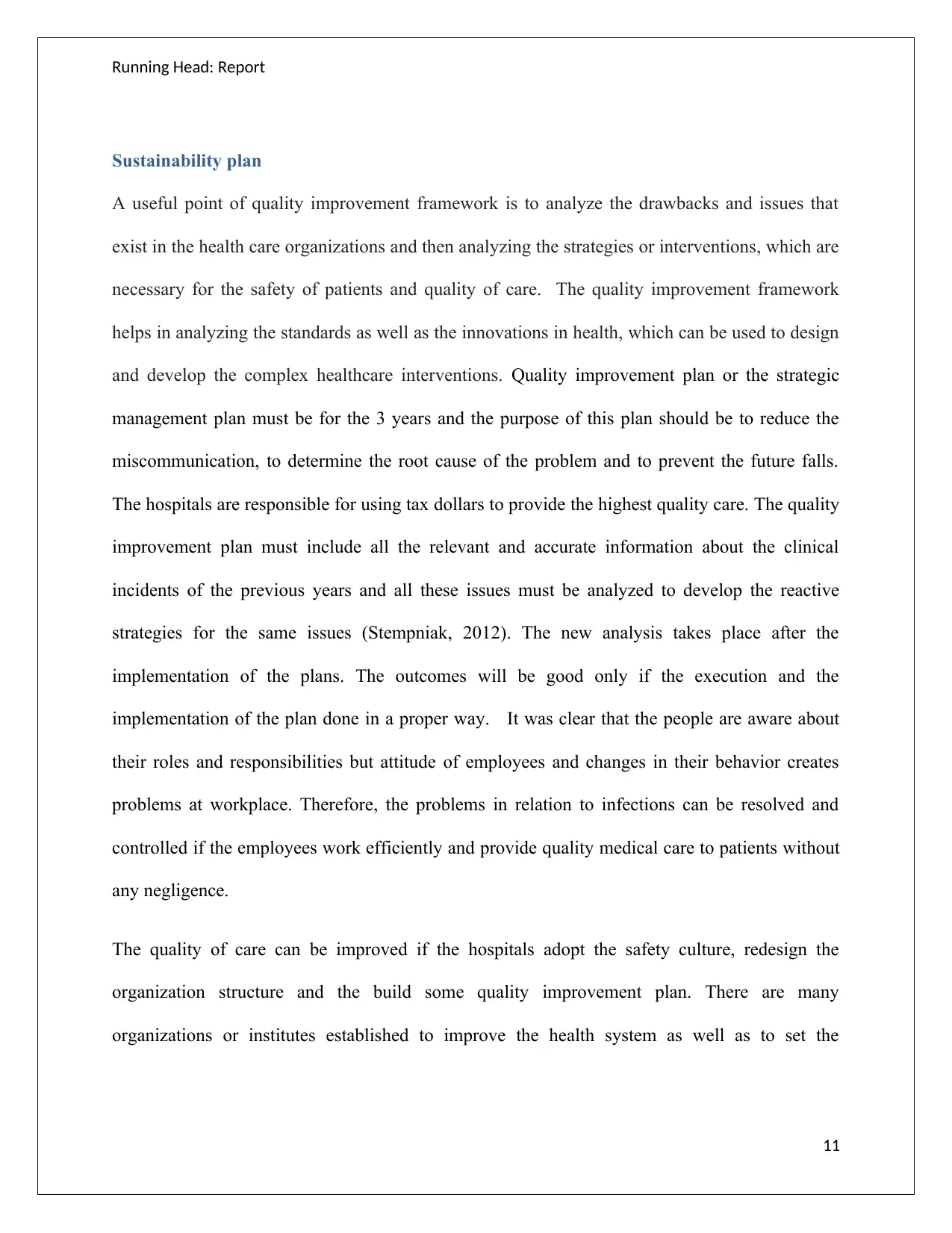
Running Head: Report
Sustainability plan
A useful point of quality improvement framework is to analyze the drawbacks and issues that
exist in the health care organizations and then analyzing the strategies or interventions, which are
necessary for the safety of patients and quality of care. The quality improvement framework
helps in analyzing the standards as well as the innovations in health, which can be used to design
and develop the complex healthcare interventions. Quality improvement plan or the strategic
management plan must be for the 3 years and the purpose of this plan should be to reduce the
miscommunication, to determine the root cause of the problem and to prevent the future falls.
The hospitals are responsible for using tax dollars to provide the highest quality care. The quality
improvement plan must include all the relevant and accurate information about the clinical
incidents of the previous years and all these issues must be analyzed to develop the reactive
strategies for the same issues (Stempniak, 2012). The new analysis takes place after the
implementation of the plans. The outcomes will be good only if the execution and the
implementation of the plan done in a proper way. It was clear that the people are aware about
their roles and responsibilities but attitude of employees and changes in their behavior creates
problems at workplace. Therefore, the problems in relation to infections can be resolved and
controlled if the employees work efficiently and provide quality medical care to patients without
any negligence.
The quality of care can be improved if the hospitals adopt the safety culture, redesign the
organization structure and the build some quality improvement plan. There are many
organizations or institutes established to improve the health system as well as to set the
11
Sustainability plan
A useful point of quality improvement framework is to analyze the drawbacks and issues that
exist in the health care organizations and then analyzing the strategies or interventions, which are
necessary for the safety of patients and quality of care. The quality improvement framework
helps in analyzing the standards as well as the innovations in health, which can be used to design
and develop the complex healthcare interventions. Quality improvement plan or the strategic
management plan must be for the 3 years and the purpose of this plan should be to reduce the
miscommunication, to determine the root cause of the problem and to prevent the future falls.
The hospitals are responsible for using tax dollars to provide the highest quality care. The quality
improvement plan must include all the relevant and accurate information about the clinical
incidents of the previous years and all these issues must be analyzed to develop the reactive
strategies for the same issues (Stempniak, 2012). The new analysis takes place after the
implementation of the plans. The outcomes will be good only if the execution and the
implementation of the plan done in a proper way. It was clear that the people are aware about
their roles and responsibilities but attitude of employees and changes in their behavior creates
problems at workplace. Therefore, the problems in relation to infections can be resolved and
controlled if the employees work efficiently and provide quality medical care to patients without
any negligence.
The quality of care can be improved if the hospitals adopt the safety culture, redesign the
organization structure and the build some quality improvement plan. There are many
organizations or institutes established to improve the health system as well as to set the
11
⊘ This is a preview!⊘
Do you want full access?
Subscribe today to unlock all pages.

Trusted by 1+ million students worldwide
1 out of 17
Related Documents
Your All-in-One AI-Powered Toolkit for Academic Success.
+13062052269
info@desklib.com
Available 24*7 on WhatsApp / Email
![[object Object]](/_next/static/media/star-bottom.7253800d.svg)
Unlock your academic potential
Copyright © 2020–2025 A2Z Services. All Rights Reserved. Developed and managed by ZUCOL.





